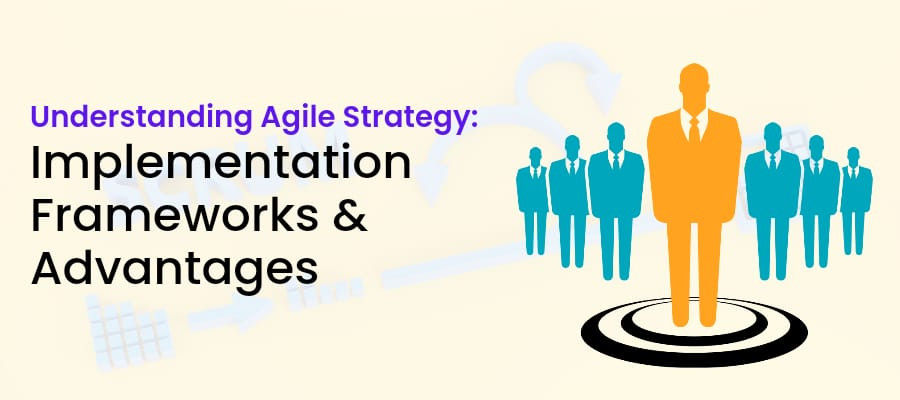Understanding Agile Strategy: Implementation, Frameworks, and Advantages

A company's marketing strategy is crucial in reaching new consumers and turning them into loyal customers. With the growing interest in Agile frameworks, businesses adopt its principles to enhance flexibility and prioritize customer needs in their marketing strategies.
In this article, we will delve into the concept of Agile strategy, explore its benefits, and provide insights into its implementation when developing a marketing strategy.
What is Agile Strategy?
Agile strategy is a dynamic and adaptable marketing approach that empowers companies to act swiftly and adapt as they perform their tasks. Unlike traditional strategies that rely on lengthy research and rigid plans, Agile emphasizes flexibility and collaboration.
Drawing inspiration from Agile project management, marketing teams can focus on experimentation, frequent activities, and responsive actions to cater to evolving consumer demands.
Implementing the Agile Strategy
To successfully implement an Agile strategy, organizations should follow these steps:
Define Objectives and Goals: Clearly define the organization's objectives and goals, ensuring they align with customer needs and market demands.
Build a Cross-functional Team: Assemble a diverse cross-functional team capable of executing the Agile strategy effectively, bringing together different perspectives and skills.
Create a Project Roadmap: Develop a roadmap outlining timelines, milestones, and key deliverables. It provides a clear direction and framework for the team's efforts.
Work in Iterative Sprints: Execute the project in short, iterative sprints, focusing on achieving the defined goals within each sprint. It allows for continuous learning, adaptation, and value delivery.
Regularly Review and Adjust: Conduct periodic reviews and adjustments based on customer feedback, market changes, and competitive dynamics. It ensures that the strategy remains aligned with evolving needs and expectations.
Promote Collaboration and Communication: Foster a culture of collaboration and open communication among team members, stakeholders, and customers. This facilitates knowledge sharing, problem-solving, and better decision-making.
Agile Strategy Frameworks
Several frameworks can aid organizations in implementing Agile strategies successfully. Some popular frameworks include:
(a) Scrum
Widely used by software development teams, Scrum involves working in short iterations called sprints. The group focuses on delivering working software within each sprint.
(b) Kanban
Kanban framework helps manage workflow and visualize work progress. It involves creating a vision board that displays the different stages of a project and the tasks that need to be completed.
(c) Lean
The Lean framework emphasizes creating value and reducing waste by optimizing the workflow. Continuous improvement is achieved by identifying and eliminating non-value-adding activities.
(d) Design Thinking
Design Thinking focuses on user-centered design to create innovative solutions. It involves understanding users, defining the problem, ideating, prototyping, and testing. Agile certification training can equip marketers with a deeper understanding of these frameworks and their application in their work.
Benefits of Having an Agile Strategy
High Level of Innovation: Agile methodology encourages experimentation, iteration, and collaboration between teams, allowing for the rapid testing of new ideas and incorporating feedback.
Increased Speed: The emphasis on speed and efficiency in Agile methodology enables teams to deliver value to customers quickly through short sprints, continuous integration, and testing.
Better Flexibility: Agile methodology provides greater flexibility in adapting to market changes, and customer needs through continuous improvement, iteration, and collaboration.
Better Adaptability: Agile methodology promotes adaptability by enabling teams to quickly adjust to market changes, customer needs, and competition through continuous review and adjustment of plans based on feedback.
Increased Collaboration: Agile methodology fosters team collaboration, leading to better communication, increased knowledge sharing, and improved problem-solving.
How Can Marketers Use Agile Strategy?
1. Communicate goals clearly
To effectively implement an Agile strategy in marketing, clear communication of goals is crucial. This involves discussing plans with all teams and documenting them for easy reference. Consider the following when identifying goals:
- Company goals: Identify the sales figures or achievements aligned with the company's vision, enabling teams to plan their approach accordingly.
- Problems and opportunities: Evaluate the issues and options that can be addressed through an Agile strategy, ensuring the availability of resources and personnel.
- Impact: Understand the potential impact of your marketing strategy on the market and customers' lives, highlighting the unique benefits of your products or services.
2. Adjust the level of details
Agile marketing allows for more general guidelines than traditional marketing strategies that provide specific measures. This flexibility will enable teams to innovate their execution strategies and be open to new ideas. While giving details for each step, encourage groups to explore new tools and methods to achieve their goals.
3. Enable autonomy
Autonomy is crucial in Agile marketing, empowering individuals to make independent decisions contributing to their goals. Embracing independence fosters confidence and encourages diverse perspectives within teams. This creates an environment conducive to learning through experimentation.
4. Evaluate results to adapt to customer needs
Once an Agile strategy is implemented, adapting practices based on customer needs is essential. Like software development, marketing teams should gather and incorporate customer feedback to prioritize features and address any issues. Regular meetings to review input and results enable teams to determine areas of focus and identify necessary resources for quick adaptation.
Conclusion
Understanding Agile strategy is essential for businesses aiming to enhance their marketing approaches. By implementing Agile methodologies, organizations can benefit from increased innovation, speed, flexibility, adaptability, collaboration, and continuous improvement.
With the right frameworks and training, marketers can leverage Agile strategies to improve their processes, responsiveness, and overall business outcomes.
Reference
- https://www.indeed.com/career-advice/career-development/what-is-Agile-strategy



